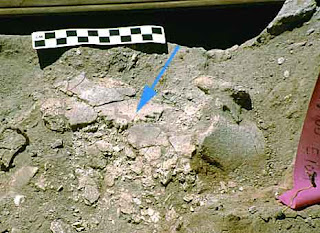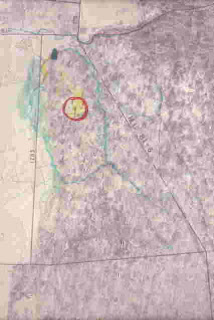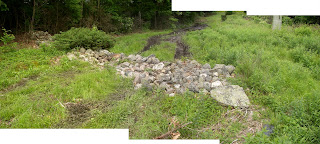
The 100-year Flood:
It was a heavy localized thunderstorm. The old timers said it was worse than the “Flood of ’55.”
I’d been working on the drainage problems on the backside of my house. I’d made a zigzag trench about ten feet from my back door, on the other side of the original well. I had a serpentine sort of swale along my flower gardens above that. Water would pour down from the highway above my house, down the upper driveway by the highway, then through the yard, and into my basement during storms (or ice melt) and I was trying to fix that. The 100-year flood storm, flowing into those depressions, actually removed soil in the center of the channel, the shape sort of forcing all the power to the middle rather than the sides.
I remember going out the backdoor to remove some debris in the zigzag and getting poked in the eye by the stalk of a plant but still being amazed that the channel was being dug out by water power for me - instead of by shovel and “me power.”
Totally soaked in seconds, I went from back door to side door to stand on the porch to watch the water flow down the side of the house and down my lower driveway to the street – it was like a good sized brook flowing through the yard. I could hear the thunder up in Bethlehem to the north where the center of the storm cell was.
The storm moved off, but in a short time I heard the strangest kind of roaring in the distance. Since it sounded like it was coming from upstream on the river, I went to my front door where I had a clearer view of the river; I can see one of the weirs the water company maintains to fill a reservoir from there across a field on the other side of the road.
The roar got louder as a wall of brown water suddenly appeared on the distant river. In minutes the floodplain turned from fields to a lake about a half-mile wide. On my side of the floodplain, the water at it’s highest flowed along what appears to be an ancient glacial lakeshore. Near the linear row that I’ve been writing about with this road re-alignment, at the low end of it, the water washed clear a row of boulders, possibly natural, perhaps not.
Somewhere I’ve got some video footage of the flooding that day and a few days after as well.
I’ve written about a stream that flows around the Burial Grounds. This big flood cleared a lot of the ancient zigzag above the first terrace “island” that is the Burial Grounds - and the serpentine rows at the low end. The branch that had been diverted to flow to the field and the river got blocked by trees, filled in with rocks and dirt. It moved back to its original location, the lower or western edge of the Burial Grounds. The serpentine row of stones on the edge of the BG was washed clear of leaves and debris, as well as a second row on the field side of this stream, a row I didn’t realize even existed.
At various places down stream, I could see remnants of the stone rows that once bordered both sides of the riparian zone of this stream, along the edge of what I think of as the “Village.” All my suspected habitation sites stayed above water.
There were many other places that the rows minimized flooding. Along one of the largest tributaries, zigzag rows on both banks of the river prevented flooding, but at a bridge that disturbed the rows and their function, the water washed away the bridge and scoured out the river almost 20 feet deep, taking away the zigzag rows downstream of the former bridge for hundreds of feet. I regret that I never took photos of those rows before the flood, back in the days before I had a digital camera. The same construction company that is working in front of my house as I write rebuilt the bridge - also destroyed those zigzag rows above the bridge site in the process, used the stone in their rebuilding efforts. I should walk up in there to see what remains upstream…
So there is a ‘hydraulic” (spell check prompts me to spell, even though I wanted to write “hydrolic”) or water management aspect to the stone rows too (Mavor and Dix mention this in “Manitou, I believe, spelling it “Hydrology”).
A drought followed the flood. I could walk streambeds and see that as the flood subsided it formed a sort of natural zigzag pattern of stones in some places. I also went up to a beaver dam that I know of, that I found by following zigzag rows, to find the flood had knocked it out – and the rows below it for quite a distance. The beavers began rebuilding it very quickly – by building a series of zigzag walls of sticks, sod, mud, and stones up from the streambed. This may be a glimpse into a similar observation made by Indigenous Peoples in the past, a bit of Traditional Ecological Knowledge inspired by the "Helping Beaver," who also participates in many versions of the Turtle Island Creation Story.
So the 100-year flood taught me a thing or two about zigzag rows. The natural processes of flooding (and beavers) could have inspired the Native American building of zigzag rows. The rows could focus the power of the water to the center of the streams, keeping them fairly clear and “in place,” protecting burials and habitation sites. A scheduled occasional burn could selectively be used to manage the land inside and outside the borders of the stone rows.
And I should add that shortly after, while making a antique furniture house call in North Salem NY, very near the famous perched boulder, I took a lunch break along the little river that flows by that big stone, just a little south of it. I sat on a zigzag row of stones on one bank, looking across the water at another zigzag row on the other bank…
It was a heavy localized thunderstorm. The old timers said it was worse than the “Flood of ’55.”
I’d been working on the drainage problems on the backside of my house. I’d made a zigzag trench about ten feet from my back door, on the other side of the original well. I had a serpentine sort of swale along my flower gardens above that. Water would pour down from the highway above my house, down the upper driveway by the highway, then through the yard, and into my basement during storms (or ice melt) and I was trying to fix that. The 100-year flood storm, flowing into those depressions, actually removed soil in the center of the channel, the shape sort of forcing all the power to the middle rather than the sides.
I remember going out the backdoor to remove some debris in the zigzag and getting poked in the eye by the stalk of a plant but still being amazed that the channel was being dug out by water power for me - instead of by shovel and “me power.”
Totally soaked in seconds, I went from back door to side door to stand on the porch to watch the water flow down the side of the house and down my lower driveway to the street – it was like a good sized brook flowing through the yard. I could hear the thunder up in Bethlehem to the north where the center of the storm cell was.
The storm moved off, but in a short time I heard the strangest kind of roaring in the distance. Since it sounded like it was coming from upstream on the river, I went to my front door where I had a clearer view of the river; I can see one of the weirs the water company maintains to fill a reservoir from there across a field on the other side of the road.
The roar got louder as a wall of brown water suddenly appeared on the distant river. In minutes the floodplain turned from fields to a lake about a half-mile wide. On my side of the floodplain, the water at it’s highest flowed along what appears to be an ancient glacial lakeshore. Near the linear row that I’ve been writing about with this road re-alignment, at the low end of it, the water washed clear a row of boulders, possibly natural, perhaps not.
Somewhere I’ve got some video footage of the flooding that day and a few days after as well.
I’ve written about a stream that flows around the Burial Grounds. This big flood cleared a lot of the ancient zigzag above the first terrace “island” that is the Burial Grounds - and the serpentine rows at the low end. The branch that had been diverted to flow to the field and the river got blocked by trees, filled in with rocks and dirt. It moved back to its original location, the lower or western edge of the Burial Grounds. The serpentine row of stones on the edge of the BG was washed clear of leaves and debris, as well as a second row on the field side of this stream, a row I didn’t realize even existed.
At various places down stream, I could see remnants of the stone rows that once bordered both sides of the riparian zone of this stream, along the edge of what I think of as the “Village.” All my suspected habitation sites stayed above water.
There were many other places that the rows minimized flooding. Along one of the largest tributaries, zigzag rows on both banks of the river prevented flooding, but at a bridge that disturbed the rows and their function, the water washed away the bridge and scoured out the river almost 20 feet deep, taking away the zigzag rows downstream of the former bridge for hundreds of feet. I regret that I never took photos of those rows before the flood, back in the days before I had a digital camera. The same construction company that is working in front of my house as I write rebuilt the bridge - also destroyed those zigzag rows above the bridge site in the process, used the stone in their rebuilding efforts. I should walk up in there to see what remains upstream…
So there is a ‘hydraulic” (spell check prompts me to spell, even though I wanted to write “hydrolic”) or water management aspect to the stone rows too (Mavor and Dix mention this in “Manitou, I believe, spelling it “Hydrology”).
A drought followed the flood. I could walk streambeds and see that as the flood subsided it formed a sort of natural zigzag pattern of stones in some places. I also went up to a beaver dam that I know of, that I found by following zigzag rows, to find the flood had knocked it out – and the rows below it for quite a distance. The beavers began rebuilding it very quickly – by building a series of zigzag walls of sticks, sod, mud, and stones up from the streambed. This may be a glimpse into a similar observation made by Indigenous Peoples in the past, a bit of Traditional Ecological Knowledge inspired by the "Helping Beaver," who also participates in many versions of the Turtle Island Creation Story.
So the 100-year flood taught me a thing or two about zigzag rows. The natural processes of flooding (and beavers) could have inspired the Native American building of zigzag rows. The rows could focus the power of the water to the center of the streams, keeping them fairly clear and “in place,” protecting burials and habitation sites. A scheduled occasional burn could selectively be used to manage the land inside and outside the borders of the stone rows.
And I should add that shortly after, while making a antique furniture house call in North Salem NY, very near the famous perched boulder, I took a lunch break along the little river that flows by that big stone, just a little south of it. I sat on a zigzag row of stones on one bank, looking across the water at another zigzag row on the other bank…
The photo above is not mine but is from an interesting article: http://pubs.usgs.gov/of/2004/1062/5_neely.pdf
















